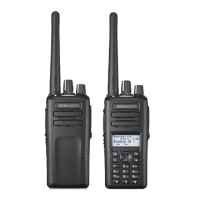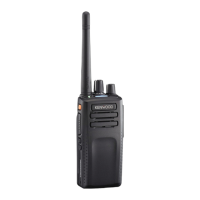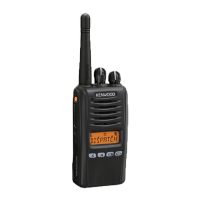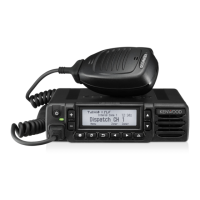Do you have a question about the Kenwood NX-320 and is the answer not in the manual?
Lists the items included in the transceiver package, such as belt clip, caps, and manual.
Instructions for attaching and detaching the optional battery pack from the transceiver.
Guide for inserting and removing AA alkaline batteries in the optional battery case.
Procedure for securely attaching the antenna to the transceiver's connector.
Steps to attach the belt clip to the rear of the transceiver using screws.
Instructions for fitting the protective cap over unused speaker/microphone jacks.
Guide for connecting speaker/microphone plugs and securing them with a locking bracket.
Explanation of various icons and indicators displayed on the transceiver screen.
Procedure for turning the transceiver on and off using the power switch/volume control.
Steps for entering the password if the transceiver is password protected.
How to control the transceiver's audio volume using the dedicated knob.
Guidance on choosing communication zones and specific channels or group IDs.
Instructions on how to initiate a transmission using the PTT switch and microphone.
Steps for making digital group calls by selecting a group ID from a list.
Procedure for initiating digital calls to specific individual units.
How the transceiver alerts and indicates incoming calls and signals.
Details on how to receive digital group calls on Conventional or Trunking channels.
Information on how to receive and respond to digital individual calls.
How to exclude specific channels from the scan sequence temporarily.
Explanation of how the transceiver automatically switches to a priority channel.
Details on the channel selected when the PTT switch is pressed during scanning.
Procedure for adding or removing zones and channels from the scan list.
How to make and receive selective voice calls to stations or groups.
Information on receiving selective calls and responding to them.
Explanation of fleet and individual ID codes used for selective calling.
How to make and receive selective voice calls using 5-tone signaling.
Details on how the transceiver handles incoming 5-tone selective calls.
Procedure for sending and receiving status messages.
How to view and acknowledge received status messages.
Accessing and managing stored messages in the transceiver's memory.
Making calls using Dual Tone Multi-Frequency signaling.
Saving and sending DTMF numbers for quick dialing.
Using the autodial feature to quickly call programmed DTMF numbers.
Using a stun code to disable a transceiver if it is lost or stolen.
Procedure for initiating emergency calls from the transceiver.
How activity detection triggers emergency mode.
Resetting the activity detection timer to prevent false emergency triggers.
Using the scrambler function for secure and encrypted transmissions.
Overview of various signaling methods like QT/DQT and OST.
Using QT/DQT tones to filter incoming calls on shared channels.
Reprogramming signaling tone or code settings on channels.
Using RAN for digital communication to filter calls by network identifier.
Information on other optional signaling methods like DTMF and FleetSync.
Using VOX for hands-free transmission activated by voice.
Setting the sensitivity level for VOX activation.
How to enable, use, and disable the VOX transmission feature.
Prevents continuous transmission for extended durations.
Reduces power consumption when the transceiver is idle.
Locks most keys to prevent accidental operation.
Indicates when the transceiver's battery power is low.
Displays remaining battery power through LED indicators.
Shows the strength of received radio signals.
Reduces noise in transmitted signals for clearer audio.
Prevents transmission on an already occupied channel.
Automatic search for a control channel on digital trunking systems.
Sending a unique ID code with PTT press/release events.
Audio announcements for zone, channel, and group changes.
Lists the items included in the transceiver package, such as belt clip, caps, and manual.
Instructions for attaching and detaching the optional battery pack from the transceiver.
Guide for inserting and removing AA alkaline batteries in the optional battery case.
Procedure for securely attaching the antenna to the transceiver's connector.
Steps to attach the belt clip to the rear of the transceiver using screws.
Instructions for fitting the protective cap over unused speaker/microphone jacks.
Guide for connecting speaker/microphone plugs and securing them with a locking bracket.
Explanation of various icons and indicators displayed on the transceiver screen.
Procedure for turning the transceiver on and off using the power switch/volume control.
Steps for entering the password if the transceiver is password protected.
How to control the transceiver's audio volume using the dedicated knob.
Guidance on choosing communication zones and specific channels or group IDs.
Instructions on how to initiate a transmission using the PTT switch and microphone.
Steps for making digital group calls by selecting a group ID from a list.
Procedure for initiating digital calls to specific individual units.
How the transceiver alerts and indicates incoming calls and signals.
Details on how to receive digital group calls on Conventional or Trunking channels.
Information on how to receive and respond to digital individual calls.
How to exclude specific channels from the scan sequence temporarily.
Explanation of how the transceiver automatically switches to a priority channel.
Details on the channel selected when the PTT switch is pressed during scanning.
Procedure for adding or removing zones and channels from the scan list.
How to make and receive selective voice calls to stations or groups.
Information on receiving selective calls and responding to them.
Explanation of fleet and individual ID codes used for selective calling.
How to make and receive selective voice calls using 5-tone signaling.
Details on how the transceiver handles incoming 5-tone selective calls.
Procedure for sending and receiving status messages.
How to view and acknowledge received status messages.
Accessing and managing stored messages in the transceiver's memory.
Making calls using Dual Tone Multi-Frequency signaling.
Saving and sending DTMF numbers for quick dialing.
Using the autodial feature to quickly call programmed DTMF numbers.
Using a stun code to disable a transceiver if it is lost or stolen.
Procedure for initiating emergency calls from the transceiver.
How activity detection triggers emergency mode.
Resetting the activity detection timer to prevent false emergency triggers.
Using the scrambler function for secure and encrypted transmissions.
Overview of various signaling methods like QT/DQT and OST.
Using QT/DQT tones to filter incoming calls on shared channels.
Reprogramming signaling tone or code settings on channels.
Using RAN for digital communication to filter calls by network identifier.
Information on other optional signaling methods like DTMF and FleetSync.
Using VOX for hands-free transmission activated by voice.
Setting the sensitivity level for VOX activation.
How to enable, use, and disable the VOX transmission feature.
Prevents continuous transmission for extended durations.
Reduces power consumption when the transceiver is idle.
Locks most keys to prevent accidental operation.
Indicates when the transceiver's battery power is low.
Displays remaining battery power through LED indicators.
Shows the strength of received radio signals.
Reduces noise in transmitted signals for clearer audio.
Prevents transmission on an already occupied channel.
Automatic search for a control channel on digital trunking systems.
Sending a unique ID code with PTT press/release events.
Audio announcements for zone, channel, and group changes.
| Frequency Range | 136-174 MHz |
|---|---|
| Operating Temperature | -30°C to +60°C |
| Operating Voltage | 7.5V DC ± 20% |
| Digital Protocol | NXDN |
| Bluetooth | No |
| Ingress Protection | IP54 |
| IP Rating | IP54 |
| Power Output | 5W |
| Battery Life | Up to 11 hours (with KNB-45L battery) |
| Channel Spacing | 12.5 / 25 kHz |
| Channel Capacity | 260 Channels |











